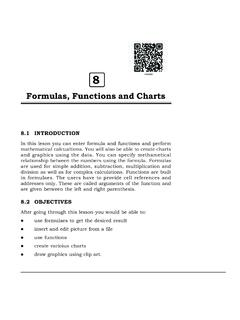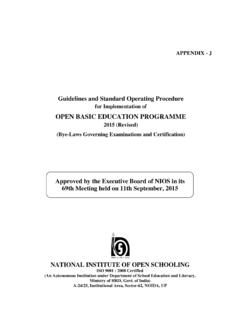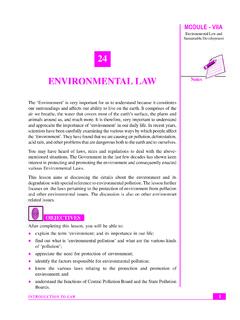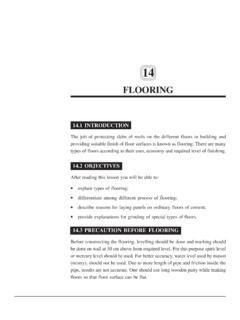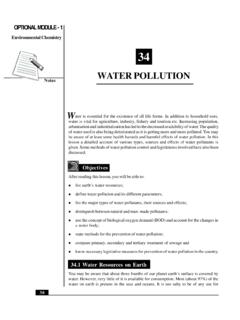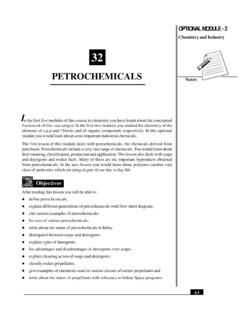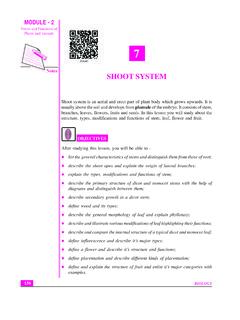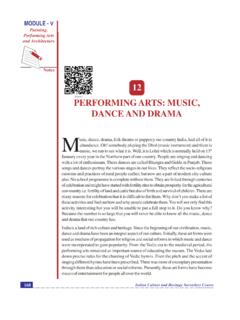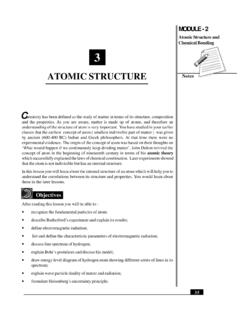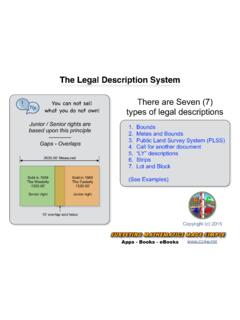Transcription of 4 ECONOMY ITS MEANING AND TYPES - National Institute of ...
1 MODULE - 2 About EconomyEconomy Its MEANING and TypesECONOMICSN otes 254 ECONOMY ITS MEANINGAND TYPESThe purpose of every ECONOMY is to satisfy human wants by using limited or scarceresources available and known to a society. These wants can be satisfied by productionand consumption of goods and services. For production, the factors of production areengaged in some economic activities. These economic activities bring income to theeconomic agents that can either be consumed or saved and invested. On account ofthese gainful economic activities and accumulated earnings, some countries grow fastwhile others cannot attain such high growth rate. As a result some economies attain thestatus of developed economies while others remain underdeveloped or developingeconomies. They are also known as rich and poor economies. We can look ateconomies on the basis of ownership of resources. The resources available may be inprivate ownership or the collective ownership. Thus there are different ways to look atthe ECONOMY and its level of development.
2 In this lesson we will explain all these termsin simple way so that you may understand and differentiate the MEANING and nature ofan ECONOMY and understand its various completing this lesson, you will be able to: explain the MEANING of an ECONOMY ; differentiate between various TYPES of economic organizations on the basis ofownership and control of resources as well as on the basis of level ofdevelopment; understand the MEANING of economic development and economic growth; distinguish between economic development and economic growth; understand the important determinants of economic - 2 ECONOMY Its MEANING and TypesAbout ECONOMY MEANING OF AN ECONOMYAn ECONOMY is a man-made organization for the satisfaction of human wants. Accordingto Brown, An ECONOMY is a system by which people get living . The way manattempts to get a living differs in major respects from time to time and from place to primitive times get a living was simple but with growth of civilization it has becomemuch more complex.
3 Here it is important to note that the way person earns his/her livingmust be legal and fair. Unfair and illegal means such as robbery, smuggling may earnincome for oneself but should not be taken into consideration as gainful economicactivity or a system of get a living . It will therefore be appropriate to call thateconomy is a framework where all economic activities are carried of the salient features of an ECONOMY are as follows:1. Economic institutions are man made. Thus an ECONOMY is what we make Economic institutions can be created, destroyed, replaced or changed. Forexample the capitalism was replaced by communism in 1917 in USSR and thecommunism was destroyed in 1989 through a series of economic reforms by formerUSSR. In India after independence in 1947 through economic and social reformswe abolished Zamindari system and introduced many land Levels of economic activities keep on Producers and consumers are the same persons. Thus they have a dual role.
4 Asproducers they work and produce certain goods and services and consume thesame as Production, consumption and investment are the vital processes of an In modern complex economies we use money as a medium, of Now-a-days the government intervention in the ECONOMY is considered undesirableand the preference for free functioning of prices and market forces is increasing inall TYPES of economic TYPES OF ECONOMIESAs you know that ECONOMY is a man-made organization, which is created, destroyedor changed as per the requirement of the society. We can differentiate in various typesof economic systems on the basis of following the Basis of Ownership and Control over Means ofProduction or ResourcesResources or means of production remain either in private ownership with full individualfreedom to use them for the profit motive or they can be in collective ownershipMODULE - 2 About EconomyEconomy Its MEANING and TypesECONOMICSN otes 27(government control) and can be used for the collective welfare of the society as awhole.
5 Based on the criterion of degree of individual freedom and profit motive,economies are labelled as:(A) Capitalist or free enterprise ECONOMY (B) Socialist or centrally planned ECONOMY (C) Mixed economyNow we shall discuss about the main characteristics of these economics in brief.(A) Capitalist EconomyThe capitalist or free enterprise ECONOMY is the oldest form of ECONOMY . Earliereconomists supported the policy of laissez fair MEANING leave free. They advocatedminimum government intervention in the economic activities. The following are the mainfeatures of a capitalist ECONOMY ;(i) Private propertyIn a capitalism system all the individuals have the right to own property. An individualcan acquire property and use it for the benefit of his own family. There is no restrictionon the ownership of land, machines, mines, factories and to earn profit and accumulatewealth. After the death of a person the property or wealth is transferred to the legal the institution of private property is sustained over time by the right of inheritance.
6 (ii) Freedom of enterpriseIn a capitalist ECONOMY the government does not coordinate production decisions of thecitizens. Individuals are free to choose any occupation. Freedom of enterprise impliesthat business firms are free to acquire resources and use them in the production of anygood or service. The firms are also free to sell their product in the markets of their worker is free to choose his/her employer. In small business units owner himself takesthe risk of production and earns profit or loss for himself. But in modern corporationsthe shareholders take risks whereas paid directors manage business. Thus the individualsupervision of one s own capital is now no longer required to earn profit. Governmentor any other agency does not impose restrictions/obstacles in the way of workers toenter or leave a particular industry. A worker chooses that occupation where his incomeis maximum.(iii) Consumer s SovereigntyIn a capitalist ECONOMY consumers are like a king.
7 They have the full freedom to spendtheir income on goods and services that give them maximum satisfaction. In capitalistsystem production is guided by consumer s choices. This freedom of consumers iscalled consumer s - 2 ECONOMY Its MEANING and TypesAbout ECONOMY 28 Notes(iv)Profit MotiveSelf-interest is the guiding principle in capitalism. Entrepreneurs know that they will ownthe profit or loss after the payment to all other factors of production. Therefore they arealways motivated to maximize their residual profit by minimizing cost and maximizingrevenue. This makes the capitalist ECONOMY an efficient and self-regulated ECONOMY .(v) CompetitionThere are no restrictions on the entry and exit of firms in a capitalism system. The largenumber of producers are available to supply a particular good or service and thereforeno firm can earn more than normal profit. Competition is the fundamental feature ofcapitalist ECONOMY and essential to safeguard against consumer s exploitation.
8 Althoughdue to large-size and product distinction monopolistic tendencies have grown thesedays still the competition can be seen among a large number of firms.(vi)Importance of markets and pricesThe important features of capitalism like private property, freedom of choice, profitmotive and competition make a room for free and efficient functioning of pricemechanism. Capitalism is essentially a market ECONOMY where every commodity has aprice. The forces of demand and supply in an industry determine this price. Firms whichare able to adjust at a given price earn normal profit and those who fail to do so oftenquit the industry. A producer will produce those goods, which give him more profit.(vii)Absence of government interferenceIn a free enterprise or capitalist ECONOMY the price system plays an important role ofcoordinating agent. Government intervention and support is not required. The role ofgovernment is to help in free and efficient functioning of the in today s worldPure capitalism is not seen in the world now-a-days.
9 The economies of USA, UK,France, Netherland, Spain, Portugal, Australia ect. are known as capitalistic countrieswith active role of their respective government in economic development.(B) Socialist EconomyIn the socialist or centrally planned economies all the productive resources are ownedand controlled by the government in the overall interest of the society. A central planningauthority takes the decisions. The socialist ECONOMY has the following main features.(i) Collective Ownership of means of ProductionIn a Socialist ECONOMY means of production are owned by the government on behalfof the people. The institution of private property is abolished and no individual is allowedto own any production unit and accumulate wealth and transfer it to their heirs. However,people may own some durable consumer goods for their personal - 2 About EconomyEconomy Its MEANING and TypesECONOMICSN otes 29(ii)Social Welfare ObjectiveThe decisions are taken by the government at macro level with the objective ofmaximization of social welfare in mind rather than maximization of individual profit.
10 Theforces of demand and supply do not play any important role. Careful decisions are takenwith the welfare objectives in mind.(iii)Central PlanningEconomic planning is an essential feature of a socialist ECONOMY . The Central PlanningAuthority keeping the National priorities and availability of resources in mind allocatesresources. Government takes all economic decisions regarding production, consumptionand investment keeping in mind the present and future needs. The planning authoritiesfix targets for various sectors and ensure efficient utilization of resources.(iv)Reduction in InequalitiesThe institutions of private property and inheritance are at the root of inequalities ofincome and wealth in a capitalist ECONOMY . By abolishing these twin institutions asocialist economic system is able to reduce the inequalities of incomes. It is importantto note that perfect equality in income and wealth is neither desirable nor practicable.(v) No class conflictIn capitalist ECONOMY the interests of the workers and management are different.
